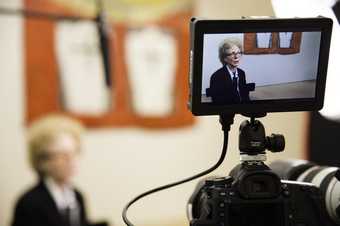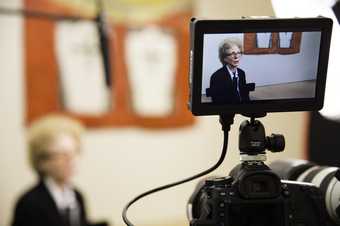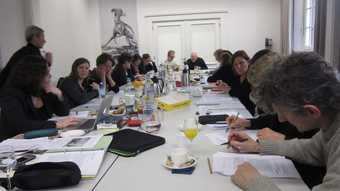
Artist Julia Scher interviewed at SFMoMA

Themes explored in the Media in Transition initiative include:
- ŌĆśLivesŌĆÖ of time-based works, key moments of transition and engagement
- Creation of works with future forms of display or realisation in mind
- Impact of strategies developed within time-based media conservation on other forms of conservation practice
- Decision making and values
- Responding to the loss of networks of production and expertise
- Ideas about documentation within artistic, art historical, curatorial and conservation practice
- Vanishing histories and fragile ecosystems
Conference
In October 2015, thanks to the support of the New Art Trust, a Media in Transition retreat was held to identify cross-currents and connections between specific case studies. This work directly informed a major international conference hosted by The Getty Conservation Institute, The Getty Research Institute and Tate, which took place at ╔½┐ž┤½├Į on 18ŌĆō20 November 2015.
The conference focused on the intersection of media art and technological change over time, and asked: How is this shifting the way museums operate and how conservation works?
Following the format of the highly successful conference in 2008 this event explored ŌĆō through papers, panel discussions, demonstrations and dialogues ŌĆō how the field is adapting and responding to these new forms of artistic practice, and how emerging modes of collaboration between artists, conservators, art historians, technical experts and curators can help advance the field.
Video recordings of the conference are available to watch via the links below.
Welcome addresses by Nicholas Serota (Director, Tate) and Jeanne Marie Teutonico (Deputy Director, Getty Conservation Institute) and an introduction by Pip Laurenson (Head of Collection Care Research, Tate)
Artists Runa Islam and Hito Steyerl present keynote talks, followed by a discussion chaired by Andrea Lissoni (Curator of International Art, Tate)
With presentations from Robin Clark (Director, Artist Initiative, San Francisco Museum of Modern Art), Rudolf Frieling (Curator of Media Arts, San Francisco Museum of Modern Art), Martina Haidvogl (Associate Media Conservator, San Francisco Museum of Modern Art) and Julia Scher (artist)
With presentations from Stuart Comer (Chief Curator, Department of Media and Performance Art, The Museum of Modern Art, New York), David Lamelas (artist) and Kate Lewis (Media Conservator at The Museum of Modern Art, New York)
Introduction to the afternon session by Jill Sterrett (Director of Collections at the San Francisco Museum of Modern Art) followed by a presentation by Monica Marchesi (Conservator, Stedelijk Museum Amsterdam)
With presentations from Francesca Esmay (Conservator, Panza Collection, Solomon R. Guggenheim Museum) and Jeffrey Weiss (Senior Curator, Solomon R. Guggenheim Museum)
Barry Smith (Director, Centre for the Senses, Institute of Philosophy, University of London)
With Jill Sterrett (Director of Collections at the San Francisco Museum of Modern Art) and Barry Smith (Director, Centre for the Senses, Institute of Philosophy, University of London)
A presentation by Christine Frohnert (Conservator of Contemporary Art, bek&frohnert).
With presentations from Hanna H├Člling (Andrew W. Mellon Visiting Professor, Bard Graduate Centre, New York and Max Planck Institute for the History of Knowledge, Berlin), Michael Mansfield (Curator of Film and Media Arts, Smithsonian American Art Museum) and SookŌĆÉKyung Lee (Research Curator, Tate Research Centre: AsiaŌĆÉPacific, Tate)
With presentations from Glenn Phillips (Curator and Head of Modern & Contemporary Collections, Getty Research Institute), Solange Farkas (Director, Associa├¦├Żo Cultural Videobrasil), Lori Zippay (Executive Director, Electronic Arts Intermix) and Jane DeBevoise (Chair, Board of Directors, Asia Art Archive, Hong Kong & New York)
With Kira Perov (Executive Director, Bill Viola Studio), Matthew Gale (Head of Displays, ╔½┐ž┤½├Į) and Pip Laurenson (Head of Collection Care Research, Tate)
With presentations from Jonah Westerman (Research Associate, Tate) and Andrew Wilson (Curator Modern & Contemporary Art & Archives, Tate)
The Capstone Session moderated by Matthew Battles, Associate Director of metaLAB (at) Harvard and a fellow at the Berkman Center for Internet and Society

Project Information
Project Type:
Conservation project
Research project
Support Departments:
Curatorial
Collection Care
Project Leader:
Pip Laurenson, Head of Collection Care Research, Tate
Steering Committee:
Marko Daniel, Convenor of Public Programmes at ╔½┐ž┤½├Į and Tate Britain
Matthew Gale, Head of Displays and Curator (Modern Art) at ╔½┐ž┤½├Į
Pip Laurenson, Head of Collection Care Research, Tate
Tom Learner, Head of the Getty Conservation InstituteŌĆÖs (GCI) Science Department
Andrea Lissoni, Curator of International Art, Tate
Glenn Phillips, Curator and Head of Modern & Contemporary Collections, Getty Research Institute
Rachel Rivenc, The Getty Conservation Institute
Jill Sterrett, Director of Collections at the San Francisco Museum of Modern Art
Show & Tell Organising Committee:
Tina Weidner, Time-based Media Conservator, Tate
Jack McConchie, Time-based Media Conservator, Tate
Louise Lawson, Conservation Manager (Sculpture & Time-based Media), Tate



